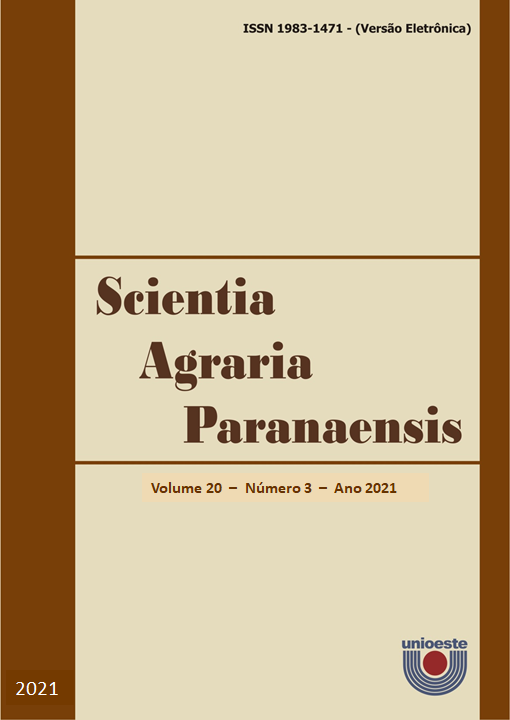Phytosociological survey of weed plants and their pasture control
DOI:
https://doi.org/10.18188/sap.v20i3.27488Resumo
Weeds damage economically interesting crop development, resulting in potential production loss of such crop. Thus, this study had de objective of surveying weeds’ phytosociology in Brachiaria brizantha (cv. Marandu) pasture and of evaluating the effectiveness of herbicides in mixtures on weeds control. The field studied has been using B. brizantha pasture for more than 10 years, divided in 4 areas with 1 ha each. After the first weeds harvest and identification, a mixture of Aminopyralid (50 g L-1) + Picloram (100 g L-1) + Triclopyr (150 g L-1) 1 L ha-1 + 1.5 L ha-1 of 2,4-D (2.5 L ha-1), Aminopyralid (50 g L-1) + Picloram (100 g L-1) + Triclopyr (150 g L -1) 2.0 L ha-1 + 1.5 L ha-1 of 2,4-D (3.5 L ha-1), Aminopyralid (50 g L-1) + Picloram (100 g L-1) + Triclopyr (100 g L-1) 1 L ha-1 + 1.0 L ha-1 of 2,4-D (2 L ha-1). After the harvests, the samples were identified and the following statistics were calculated — absolute frequency, relative frequency, absolute density, relative density, absolute abundance, relative abundance, and importance value index. The obtained phytosociological survey in pasture planting presented five families — Fabaceae, Malvaceae, Asteraceae, Euphorbiaceae, and Solanaceae —, and using Aminopyralid (50 g L-1) + Picloram (100 g L-1) + Triclopyr (100 g L-1), adding up to a mixture of 1.0 L ha-1, mixed with 1.0 L ha-1 of 2,4-D, was effective in the control of weeds in the pasture area.
Downloads
Publicado
Como Citar
Edição
Seção
Licença
Aviso de Direito Autoral Creative Commons
Política para Periódicos de Acesso Livre
Autores que publicam nesta revista concordam com os seguintes termos:
1. Autores mantém os direitos autorais e concedem à revista o direito de primeira publicação, com o trabalho simultaneamente licenciado sob a Licença Creative Commons Attribution que permite o compartilhamento do trabalho com reconhecimento da autoria e publicação inicial nesta revista.2. Autores têm autorização para assumir contratos adicionais separadamente, para distribuição não-exclusiva da versão do trabalho publicada nesta revista (ex.: publicar em repositório institucional ou como capítulo de livro), com reconhecimento de autoria e publicação inicial nesta revista.
3. Autores têm permissão e são estimulados a publicar e distribuir seu trabalho online (ex.: em repositórios institucionais ou na sua página pessoal) a qualquer ponto antes ou durante o processo editorial, já que isso pode gerar alterações produtivas, bem como aumentar o impacto e a citação do trabalho publicado (Veja O Efeito do Acesso Livre).
Licença Creative Commons
Esta obra está licenciada com uma Licença Creative Commons Atribuição-NãoComercial-CompartilhaIgual 4.0 Internacional, o que permite compartilhar, copiar, distribuir, exibir, reproduzir, a totalidade ou partes desde que não tenha objetivo comercial e sejam citados os autores e a fonte.


